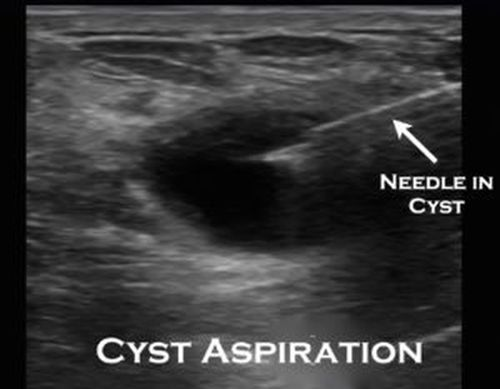Cysts are fluid filled sacs within the breast. These sacs form when normal milk-producing glands enlarge. The cause of this enlargement is not definitely known but is very likely related to an imbalance between the normal production and absorption of fluid. Breast cysts may be solitary but are most commonly multiple and can vary in size from microscopic to larger than a ping-pong ball.
Ultrasound-guided cyst aspiration is a simple and effective technique which serves a dual purpose. It confirms the nature of the lump as “cystic” or “solid” and extracts fluid from a cyst which frequently makes the lump disappear. If no fluid is obtained, the lump is presumed not to be a cyst and whatever material is aspirated may be sent to the laboratory for analysis.
When a cyst is discovered by ultrasound, aspiration is not generally recommended unless the cyst has some unusual features on the ultrasound image. In some cases, if the patient is experiencing physical or emotional discomfort, the cyst can be relieved by aspiration.
Ultrasound imaging uses a small probe, called a transducer, and gel placed directly on the skin. High-frequency sound waves travel from the probe, through the gel, into the body. The probe collects the sounds that bounce back. A computer uses those sound waves to create the images for the exam.
Ultrasound is painless and non-invasive.
When would I get a Cyst Aspiration?
Breast cysts are common, particularly in women aged 40-60. Although larger cysts can sometimes be felt as “lumps”, many cysts are undetectable by physical examination.
Cysts are frequently seen as round masses on mammograms. When this occurs, breast ultrasound examination is usually performed. Breast ultrasound is the most sensitive and accurate method for the identification and diagnosis of breast cysts. With modern ultrasound, accuracy rates of 95 to 100 percent can be expected.
Virtually all breast cysts identified as “simple cysts” by ultrasound are benign and remain so. It is estimated that perhaps 1 in 1,000 cysts may harbor a tumor, although not necessarily malignant. These can usually be identified by their ultrasound appearance.
Women with cysts are not at greater risk for the development of cancer although this risk may be minimally elevated if there is a positive immediate family history for breast cancer in the mother, a sister or a daughter.

What Will I Experience?
In breast cyst aspiration, the radiologist uses a small needle to make sure that the breast lump is a cyst, and to drain fluid from it.
You will be lying on your back or slightly turned on your side. The ultrasound transducer is used to locate the cyst. Your breast will be cleansed with an antiseptic. Next, the radiologist will numb the part of the breast close to the location of the cyst by injecting local anesthetic with a tiny needle. You may feel a little stick and some very brief stinging at this point.
After the local anesthetic has taken effect, the radiologist, while constantly monitoring the cyst site with the ultrasound probe, guides a small needle directly into the cyst and attempts to withdraw fluid.
When the procedure is completed, sterile gauze will be pressed against the area for several minutes to prevent bleeding. Polysporin ointment and a band aid will be placed over the puncture site.
If the lump is a cyst that contains watery fluid, but not blood, and the cyst goes away after aspiration, you will not need other tests. If the fluid is bloody, your doctor will send the fluid to a lab to see what it is. If the lump in your breast is solid or contains bloody fluid, your doctor will send you to a surgeon for a biopsy.
Typically, ultrasound-guided breast cyst aspiration takes approximately 60 minutes to complete.


